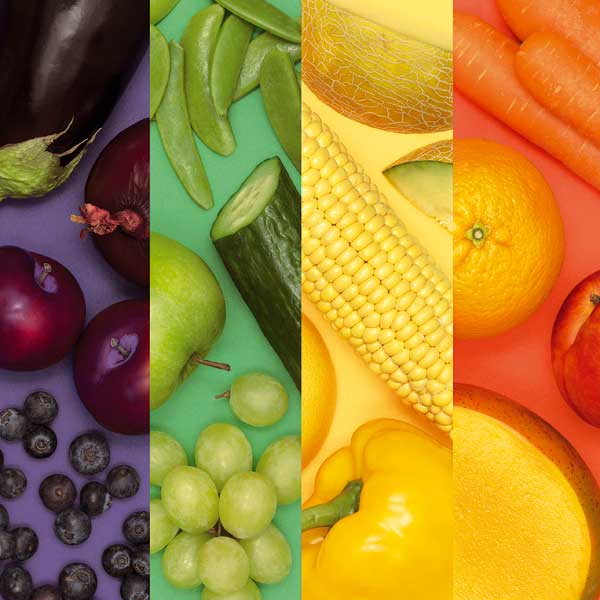Eat the rainbow
Eating brightly coloured fruit and vegetables can keep you fit and healthy and protect against certain cancers, arthritis, heart disease, cataracts and even premature ageing, reports Juliette Kellow.

As children we might have been told to ‘eat our greens’, but now health experts agree it’s just as important to eat our reds, oranges, yellows, blues and purples, too. Scientists now know that many of the naturally occurring chemicals (phytochemicals) responsible for giving fruit and veg their bright colours actually help keep us healthy and free from disease. Fruit and vegetables contain hundreds of colourful phytochemicals that act as antioxidants, which help to ‘mop up’ potentially harmful molecules called free radicals before they get a chance to damage cells.
As a result, antioxidant-rich fruit and vegetables can help to protect against a whole host of problems, including heart disease, cancer, cataracts and even premature ageing.
Research shows phytochemicals in fruit and vegetables of various colours also offer other health benefits. As a result, as well as encouraging us to eat five servings of fruit and vegetables a day, nutritionists now say it’s important to choose a ‘rainbow’ of colours. This means picking one daily serving of fruit and vegetables from each of the four colour groups – red, orange/ yellow, green, and purple/blue.
All those different colours will add plenty of flavours and textures to dishes, making meals not just more healthy, but more enjoyable and satisfying.
Red
Choose from
: raspberries, cranberries, strawberries, cherries, pomegranates, apples, grapes, rhubarb, pink grapefruit, watermelon, guava, tomatoes, peppers, radishes, radicchio and potatoes.
What they contain
: Lycopene (a carotenoid) and anthocyanins (a flavonoid) are two of the main pigments that give fruit and vegetables a red colour. Many of these also provide good amounts of vitamin C.
Why they are good for you
: Tomatoes, watermelon, guava and pink grapefruit are a good source of lycopene, which may help protect against some cancers, especially prostate cancer. We absorb lycopene more easily when foods have been heated, so processed tomatoes are better than raw. Fat, such as olive oil or cheese, also helps enhance absorption. Anthocyanins, found in red fruits, may help fight cancer, keep the heart healthy, improve vision and memory and avoid urinary tract infections.
Green
Choose from
: asparagus, avocado, rocket, spinach, lettuce, watercress, cucumber, broccoli, Brussels sprouts, leafy cabbage, spring greens, beans, peas, sugar snap peas, mangetout, cress, courgette, peppers, spring onions, leeks, apples, grapes and kiwi fruit.
What they contain
: Green fruit and veg are coloured by a pigment called chlorophyll. Many are good sources of two carotenoids called lutein and zeaxanthin, plus they contain phytochemicals such as indoles and glucosinolates and nutrients such as beta-carotene, folate, iron and calcium.
Why they are good for you
: Research shows that lutein and zeaxanthin act as ‘natural’ sunglasses and filter out harmful light that can damage the eyes. A good intake of these antioxidants may help prevent age-related macular degeneration, a leading cause of blindness, and may help protect against cataracts. Green vegetables may also help protect against cancer.
Purple/blue
Choose from
: blackberries, blueberries, grapes, blackcurrants, plums, prunes, raisins, red cabbage, red onions, and aubergine.
What they contain
: Purple and blue fruits and vegetables are coloured by phytochemicals called anthocyanins. Many of these foods also contain ellagic acid and proanthocyanidins.
Why they are good for you
: Anthocyanins may help to keep the heart healthy and reduce the risk of strokes, while ellagic acid may help to protect against cancer. Good intakes of anthocyanins have also been linked to improving balance, co-ordination and short-term memory in old age, as well as better vision, although more research needs to be carried out to confirm these findings. Research shows that proanthocyanidins may help to protect against urinary tract infections.
Orange/yellow
Choose from
: apricots, cantaloupe and Galia melons, mangoes, peaches, papaya, oranges, satsumas, grapefruit, pineapple, nectarines, carrots, swede, sweet potatoes, butternut squash, yellow and orange peppers, pumpkin and sweetcorn.
What they contain
: As well as being a good source of vitamin C, yellow and orange fruits contain carotenoids such as beta-carotene and beta-cryptoxanthin.
Why they are good for you
: With the exception of citrus fruits and pineapple, most yellow and orange foods are packed with beta-carotene, which the body converts to vitamin A – good for vision in dim light and maintaining the skin and cells that line the airways and the digestive and urinary tracts.
Beta-cryptoxanthin – in mangoes, nectarines, peaches, peppers and citrus fruit – may maintain the respiratory tract, reduce the risk of lung cancer and ease inflammation associated with arthritis.
Was this article useful? Log on and tell us what you think.
Subscribe to our magazine
Food stories, skills and tested recipes, straight to your door... Enjoy 5 issues for just £5 with our special introductory offer.
Subscribe
Unleash your inner chef
Looking for inspiration? Receive the latest recipes with our newsletter